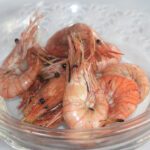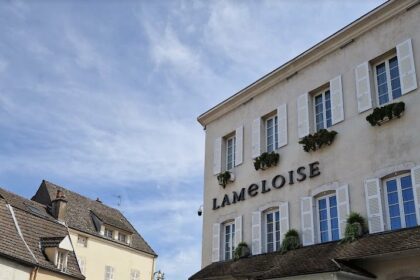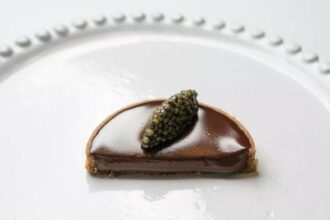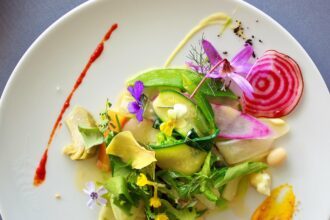Following our trip to Alba, we had four more outstanding meals in Italy: superb fresh seafood at Alla Testiere in Venice, some of the best charcuterie from cinta senese pork products at Pompiere in Verona and two unforgettable meals at Le Calandre in Rubano near Padua and Da Vittorio in Bergamo. Le Calandre has been a favorite of mine for some time. At the outset, I will make the strong claim that, of all the 2 and 3 Michelin starred restaurants that we have been to in Italy in the last 3 years (the list includes Dal Pescatore, Miramonti l’Altro, Perbellini, Cracco-Peck, Da Caino, Don Alfonso, Gambero Rosso and Flipot), Da Vittorio and Le Calandre are the 2 best, although none of the above have disappointed me.
These two restaurants could not be more different in style and philosophy. Le Calandre is modern, sleek and a touch avant-garde. The chef Massimiliano Alajmo is very young, tall and slender. His dishes incorporate some of the state of the art techniques that he learned at Veyrat and Adria, while never imitating them. The Cerea clan at Da Vittorio, on the other hand (papa Vittorio and sons/nephews Francesco, Bobo and Chicco), are cooking a type of regal cuisine that in my imagination I associate with the grand style of the Risorgimento period. This is the place I would have liked to invite my literary hero, Giuseppo di Lampedusa, and I am sure that his Prince Don Fabrizio would have felt at home there. At any rate, you do not have to be a Prince or a Sultan to get treated there like one—in the tradition of the great Italian hospitality. In this sense, I cannot think of better hosts than the Alajmo family (Massimiliano’s brother Raffaele is in charge of both the dining room and the wine list), the charming Cerea ladies who are the daughters of Vittorio, and our captain Nicola who anticipated all our needs and displayed the most stunning acts of generosity I have experienced in my eating out career in a totally understated, refined and elegant Italian way. We can contrast this with what some American restaurants do. When they do not charge corkage or give you an extra course, they list this on your check—which often comes before you ask—and they list the item with a capitalized “No Charge” caption as if you are too insensitive to understand favors.
Stylistic differences aside, what unites these two institutions is their overriding concern for high quality ingredients and raw materials. Everything you eat, from a pedestrian vegetable to ultra luxurious Alba truffles or seafood, are very good, and so incredibly intense and delicate at the same time.
Alajmo is playing with some Adria-like textures, soft or liquid filled interior and crunchy exterior, and his amuses like a mini beignet filled with tomato juice (tomato juice injected with a syringe I guess) and, other goodies, such as ethereal potato and eggplant purees in thin pastries, are nice ways to start a meal.
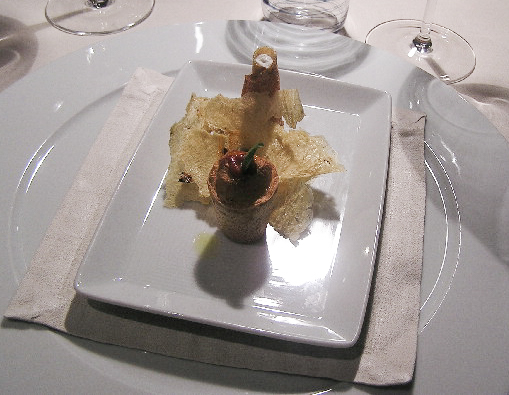
His second amuse, the obligatory (in this season) pumpkin soup mixed with parsley cream was better than any other pumpkin amuse that I have had in France and Switzerland recently. This is presumably because he did not need extra butter to highlight the natural sweetness of pumpkin. My only qualm is that pumpkin would have benefited from some thinly sliced white Alba truffles: they both flourish this season and call for each other.

Alajmo is a minimalist in the sense that some of his best dishes contain only 3 to 4 elements. Each of them shine and complement each other, rather than contrasting with one another, a la Gagnaire. This simple looking ricotta mousse flavored with orange and topped with creamy mussels and shaved bottarga is a case in point. This is a very appetizing and delicious dish. The minute details are well thought out and the quality of ingredients is top. For instance, the bottarga is made from pressed grey mullet or cefalu fish rather than from a variety of tuna fish. The latter is more oily and less delicate, and for a Turkish, it is considered second quality. In Italy, I mostly find inferior quality bottarga compared to Turkey and I was surprised to see the best quality in Le Calandre (apparently from Sicily).
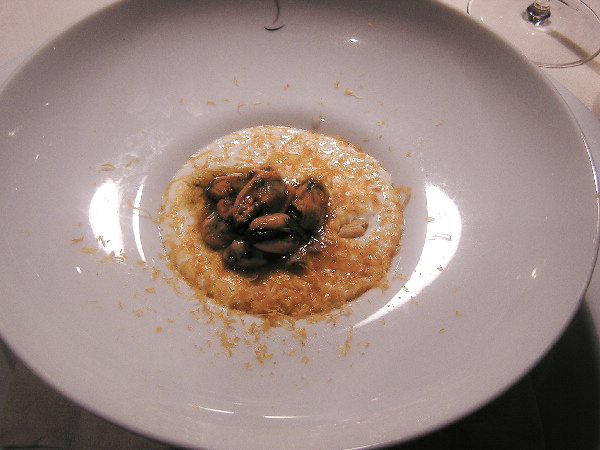
I was even more flabbergasted with the next dish. I have a special fondness for rock and deep sea fish, and they are getting rarer and sometimes extinct. If you have had a true rouget-barbet de roche, you will know how good they taste—a world apart from insipid farm raised sea bass and daurade or dorata which are now commonplace in Europe and are imported to the States and served with great fanfare in the US. My meal at the French Laundry on November 7 for instance featured a tasteless sea bass from Europe. At any rate some rockfish, like capon, are rarer than rock rouget and you have to order them in great restaurants in France, such as Le Louis XV when you make the reservation. I did not know that they are now almost extinct species of the Mediterranean, the very ugly lahoz and orfoz even existed in Europe. I know some restaurateurs at Bodrum, a beautiful seaside village in Turkey, and they call me when they can fetch one of these rare and ugly species, which weigh 3 to 4 kg. and live deep, very deep, under the sea. They are often caught by scuba divers and this is a reason why they are so rare and expensive. To cut the story short, Massimiliano had the right contact to bring one orfoz (in Italian a cernia, black variety which is even tastier than the grayish one) from Sicily. Thinking that I was American because we converse in English, they called it a “stone sea bass” which does not make sense. It is closest in taste to Spanish mero, which should not be confused with the ubiquitous and rather bland merluza (except its cheeks are good). They should have told me that it was “merou noir” which would have saved some confusion. At any rate the taste was as good as rock fish gets and it was served with a crouton on top in a very Mediterranean style, with a confit tomato, tapenade and a light mousse from lima bean sprouts.
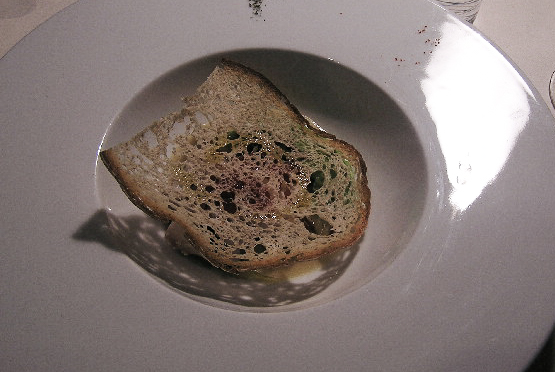
The next dish was a tortelli di zucca. This dish is a classic at the three starred Dal Pescatore where they mix squash with amaretti cookies. Here, they “deconstructed” the dish by concocting little jellies from amaretti and drizzling some coffee powder on top. It was very good, but not as good as the Dal Pescatore’s more simple yet heavenly preparation.
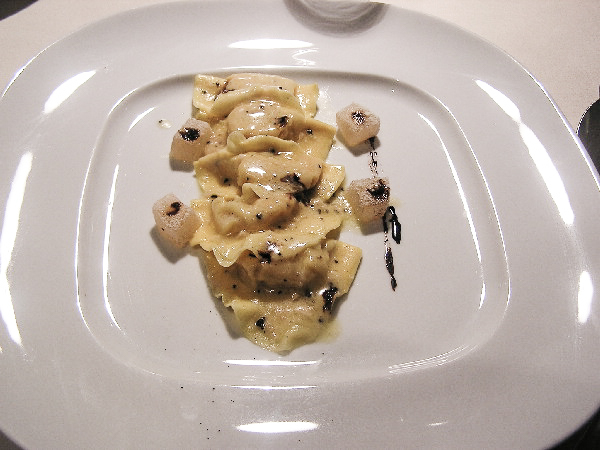
But then Massimiliano beat any egg-truffle combination I had had by serving a poached farm egg, sitting atop fried bread and surrounded by fonduta. Very classic and solid, a time tested vehicle for truffle slightly modified by the existence of crostini at the bottom and a very light parsley mousse for color and texture. The ample truffle slices were from rovere or oak tree, and although I did not ask the source of the fonduta, I suspect it was classic, two different kinds of fontina.
Massimiliano prepares the best risotto of which I am aware, that can be equaled but not surpassed. His risottos are creamy, firm and very flavorful without being too heavy. I had had his licorice/saffron as well as coffee powder risottos, and this time, the period being late November, he cooked to order for the two of us a risotto with white truffles and cubes of meat jellies. He grated truffles from 2 different trees, and the more white truffles below are from hetre (in French) or beech tree. My wife was served from the oak tree, darker truffles. We tried to compare them, but we could not make up our minds.
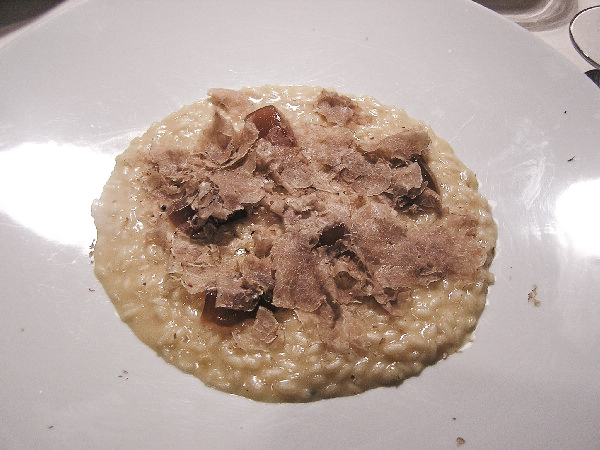
We always order piccione or baby squab at Le Calandre because the quality is better than anywhere else, the level of the old good Jamin of Robuchon. It is also better than what I have had at Grand Vefour, Gagnaire, and Les Ambassadeurs under Piege. They say that their pigeon comes from a special farmer who is a classical music fan and he raises his pigeons by having them listen to Bach and Beethoven. This probably explains all there is to explain! Maximiliano also knows how to handle the squab and it is one place where the breast is rare and the thigh is so crisp and juicy that it falls from the bones. Sauces vary. The first time it was with foie gras. The second time was with cherries and cherry liquor (my favorite of the three). This time he became more “Asian” (I noticed some Asian apprentices in the kitchen) and he crusted his pigeon with sesame seeds. He also made a soy and sesame oil based sauce and prepared a sesame paste as a dip. He also included fresh soy bean sprouts to complement the Asian style dish. The overall effect is to render the tender and gamey pigeon a bit more earthy and harder to match with wine compared to his other versions which I prefer.
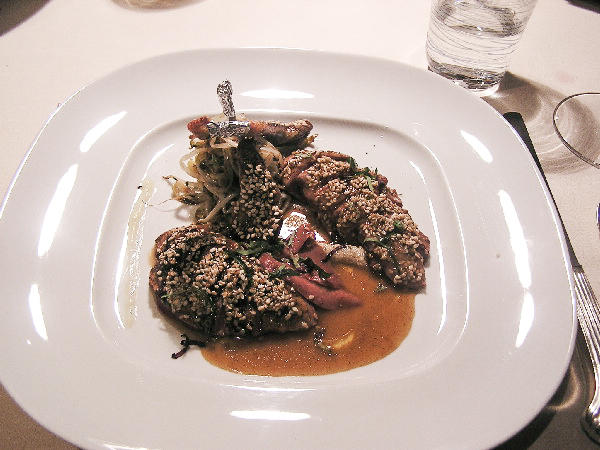
Next course, suckling pig was as good as Da Renzo’s version. Massimiliano sources Piemontese pig and cooks it slowly for 48 hours. The skin is very crunchy. It is served with wild chicory, honey infused mustard sauce and some coffee powder which actually adds to the flavor. I thought it is the type of dish one expects from Passard, had he not been so stubborn about cooking meat. Maybe he just cannot find this quality in France!
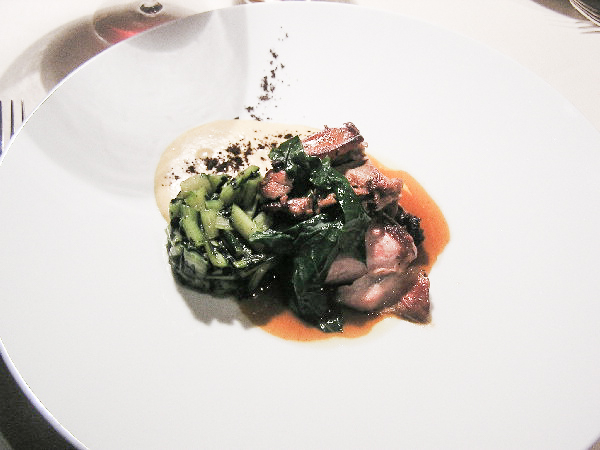
We were kind of getting full, but they wanted to show us the last meat dish on their menu, testicles of young bull in a very Venetian Valpolicella wine sauce and served with a heavenly chestnut/ginger puree. Had I closed my eyes and not known what I was eating, I would have said I was eating some kind of fish’s liver, possibly a monkfish liver that I have in Japanese restaurants. Bravo Massimiliano for not caving in to the expectations of international clientele and for preparing rustic dishes.
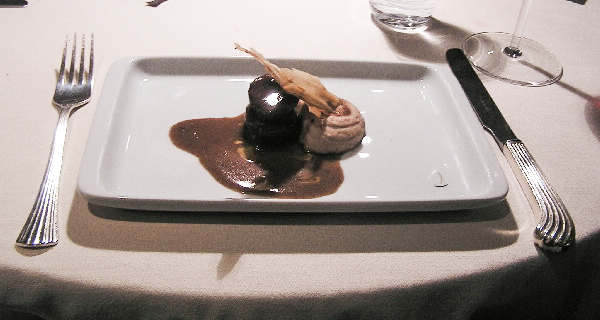
Desserts are improving at Le Calandre. Or, they understand my taste and advise us better. Both the three-layered grapefruit dessert (with three kinds of grapefruit, home made jellies and lemon-gin sorbet on top) and Massimiliano’s take on cassata (with layers of ricotta mousse, white chocolate, pistachio cream and apricot mousse with thin cookies on top) were light and explosive in fruit taste. When we finished our dolce we certainly were no longer hungry, but not uncomfortably full either. So we did what was called for: move to the champagne bar to finish a great meal with espresso and aged Calvados.
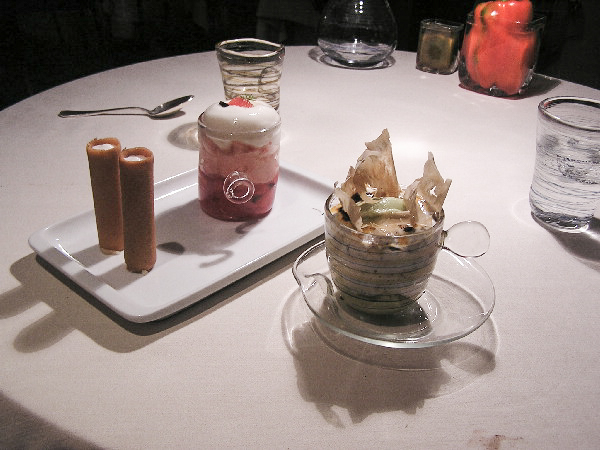
Rating of Le Calandre: 18/20
Two days after our feast at Le Calandre, we moved from Verona to the beautiful old town of Bergamo. I wanted to get hungry by visiting some beautiful places, so we drove in the early afternoon to Bellagio by Lake Como. We got caught in traffic on our way back and made a wrong turn into the commercial center in Bergamo which turned out to be outside Bergamo rather than in the center. Given the traffic problems, I became tense and edgy. This was not a good omen before a meal with high expectations.
My mood changed as soon as we stepped into the holy abode of the Cerea family (not much longer though—this summer they are opening a Relais et Chateaux). Genuine smiles and the existence of a voiturier so that you do not have to look for difficult parking are good things. As soon as we were seated in a very nice corner table in a beautiful cozy room full of flowers, all my senses were awakened and I almost had a headache from the intense perfume of that most intoxicating product on earth: the white truffles from Langhe. I could not see them, but their aroma was all over. Upon my questioning, our gracious captain Signor Nicola whose qualities would reveal themselves gradually but surely into the wee hours of the night, showed up with a basket full of incredibly aromatic truffles, each weighing a pound or more. They arrived on the same morning: it was a Thursday and the restaurant is closed on Wednesdays. At that point, my facial expression completely changed from a sour face to a genuine smile.
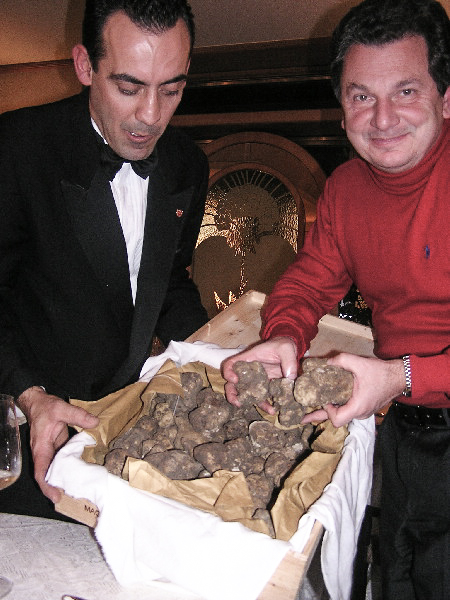
When I am in a good mood and in a special restaurant I derive more joy from the process of planning my meal than anything else. I try to lengthen this process, weigh the alternatives, ask a million questions, relish the sheer joy of visualizing various possibilities in sequencing and wine pairing, etc. Here my preferred activity was under serious challenge as Da Vittoria is known for seafood, but they had a crustaceans and molluscs menu for 2 with no description. While I did not want to miss shellfish, I also had to try dishes with truffles and the veal cheek mentioned by my friend. As we had only eaten a couple of clementines the whole day, we were very hungry. I stated all my preferences to Nicola and to Vittorio’s (he was also in the dining room with his wife) charming daughter. I asked insistent questions about the source of ingredients (such as “where does your aragosta come from?”, “do you have gamberi di San Remo?”), and then I let them put together a menu for us with shellfish, truffles, veal cheeks and suckling pig.
After some bacalao croquettes and little anchovy tarts that they serve as amuse bouche, they brought the first set of four cold antipasti. They were wild sea bass carpaccio with salmon caviar and truffles; Passard style soft boiled egg with what I thought was maple syrup and truffles; incomparably fat seasoned and not smoked raw Scottish salmon with chive-cream and toast; and sashimi grade tuna with carpaccio.
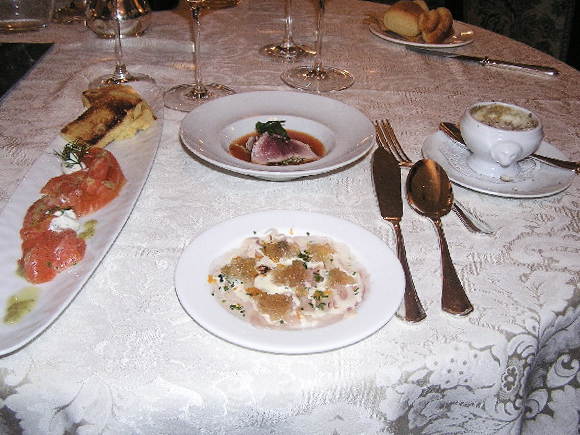
Then came the second set of four hot antipasti. These included a Robuchon-like creamy potato puree with leeks from Cervere, melted brie cheese and, of course, truffles; some very small and deep-fried lake fish sandwiched between two layers of crisp hash browns and topped by velvety Béarnaise; Atlantic lobster tail and claw in an intense sauce nantua that the French rarely make nowadays; and finally two big langoustines (scampi), as fresh as the ones at Alla Testiere but bigger. They were not hidden in phyllo sheet as is a la mode nowadays and nor unnecessarily embellished by caviar. I think that the langoustines had never seen the ice and have been kept in salted sea water to be that fresh-sweet tasting and non-iodized. They were simply served with home made mayonnaise.
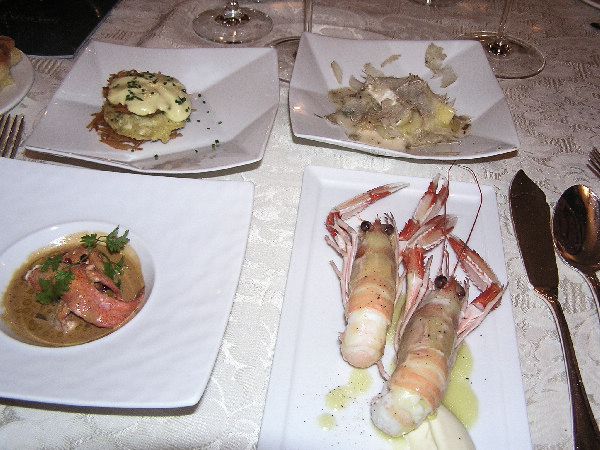
I was not expecting any more shellfish, but a miracle happened and six mid-sized gamberi di San Remo arrived. For those who know how they taste, since they are now very rare, there is no need to reiterate. For those who do not know, I can only say that they are adorable. The photo below may give an idea about the freshness and the accuracy in timing when cooking them.
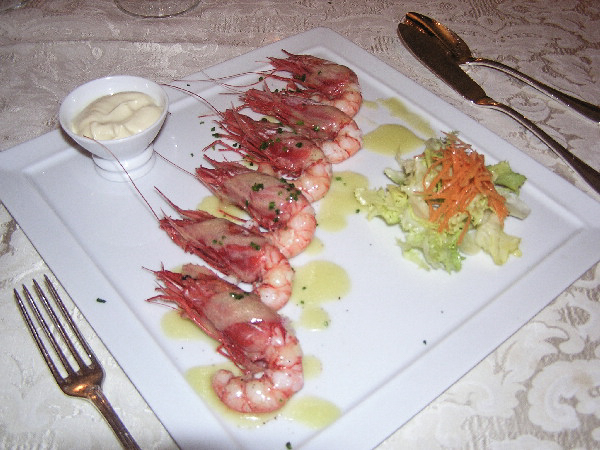
One gets very picky about the quality of pasta when one eats artisanal preparations in Italy. Pasta dishes in multi-starred Italians sometimes disappoint me: they end up a bit fussy by trying to be original. This was not the case at Da Vittorio. We had simply the best gnocchetti, made different from gnocchi by mixing cheese with the dough, ravioli with castelmagno, my favorite Piemontese cheese, and hand cut tagliolini, with duck stock. They were all topped with a generous quantity of ripe, perfumed Alba truffles.
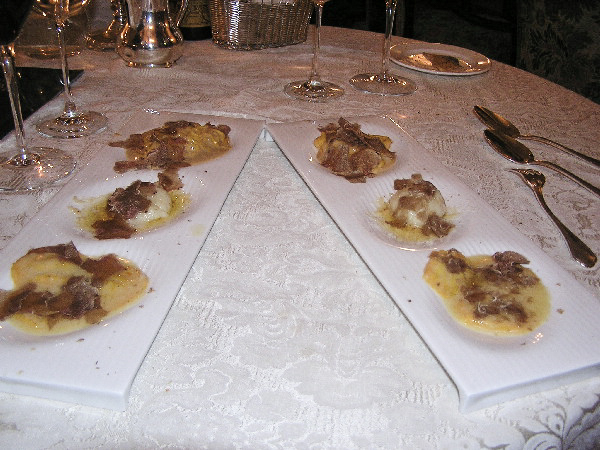
Da Vittorio serves porchetta a bit like Da Cesare serves baby goat: they want you to taste different parts of the animal, the leg, shoulder and ribs. The skin was glazed with honey and the intense sauce contrasts with Spanish pine nuts and raisins which they include in ample quantities. This dish was less refined than what we had at Le Calandre and Da Renzo, but equally tasty. It reminded me of Zuberoa’s very intense and non-compromising roasts. Porky intense pig.
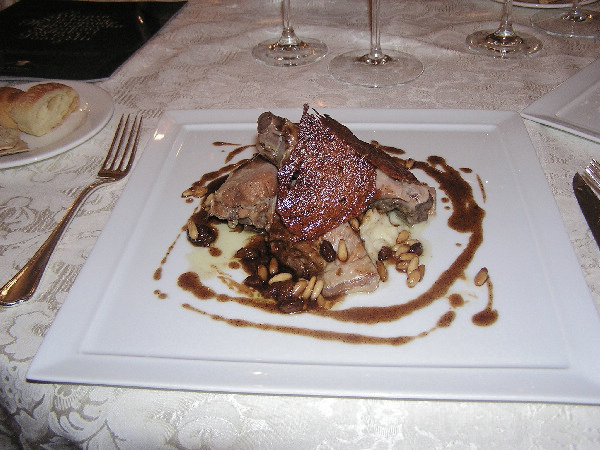
Caramelized veal cheeks were as good. Accompanied by an intense red wine sauce, they were full of flavor and very tender at the same time. Baby vegetables were all fine, esp. the fennel added a welcome exotic touch to the dish, but especially noteworthy was the best soft polenta I put to my mouth, which was topped with homemade salsiccia or very firm veal sausages. Another triumphant dish.
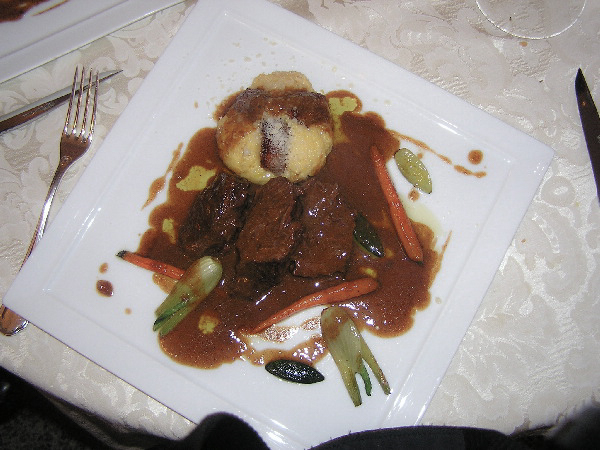
I do not think that anybody can accuse Da Vittorio for being less than generous with desserts. Before they brought our desserts, they wheeled two carts in front of us which were filled with all kinds of little bonbons, chocolate truffles, caramels, liquor filled round chocolates, orangettes, etc. Well, since the days of Robuchon‘s Jamin, I have never witnessed such a gesture in the grand old European tradition. But before moving on to the little goodies, we were served 5 sorbets, on par with the level in Dal Pescatore which serves superb sorbets. They were: chestnut, campari, passi on fruit, lemon and a mix of berries.
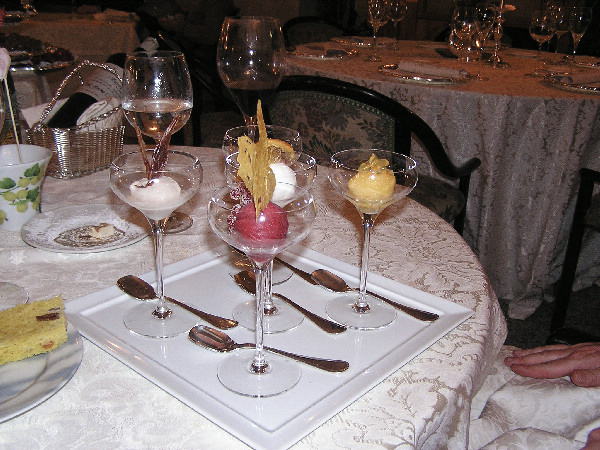
Then seven little sins or desserts arrived. There was a three layered fruit-chocolate mousse that you see in the middle with the spoon which was interesting because it was offered with wasabi ice cream. Ripe raspberries with sabayon were very good. In general their desserts made me think that the dessert chef went to Gagnaire and was influenced. At the moment, the desserts do not reach the level of Gagnaire’s grand dessert.
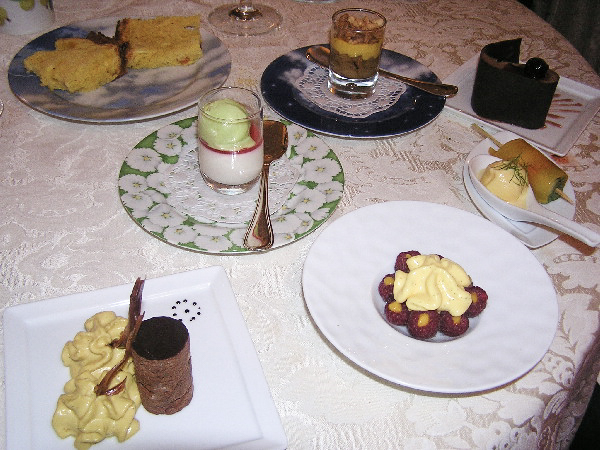
But the little goodies, particularly the nougatines and the sambuca, cognac and grappa filled chocolates were very good. But they were overshadowed by my after dinner digestive: an 1899 Bas Armagnac Laberdolive. Such a once in a lifetime drink is not only an apt finish to a memorable meal, but makes you contemplate about the transient nature of pure joy and more durable bonds of friendship. We left the restaurant feeling bonded with the Cerea family who, with no doubt, are trying to give their guests all they can. This was a fitting ending to our one week trip to Northern Italy.
Rating of Da Vittorio: 18/20

